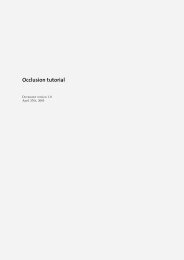mental ray Architectural and Design Visualization Shader Library
mental ray Architectural and Design Visualization Shader Library
mental ray Architectural and Design Visualization Shader Library
You also want an ePaper? Increase the reach of your titles
YUMPU automatically turns print PDFs into web optimized ePapers that Google loves.
Chapter 2<strong>Architectural</strong> Material2.1 Introduction2.1.1 What is the mia material?The <strong>mental</strong> <strong>ray</strong> mia material is a monolithic material shader that is designed to support mostmaterials used by architectural <strong>and</strong> product design renderings. It supports most hard-surfacematerials such as metal, wood <strong>and</strong> glass. It is especially tuned for fast glossy reflections<strong>and</strong> refractions (replacing the DGS material) <strong>and</strong> high-quality glass (replacing the dielectricmaterial).The major features are:• Easy to use - yet flexible. Controls arranged logically in a “most used first” fashion.• Templates - for getting faster to reality.• Physically accurate - the material is energy conserving, making shaders that breaksthe laws of physics impossible.• Glossy performance - advanced performance boosts including interpolation, emulatedglossiness, <strong>and</strong> importance sampling.• Tweakable BRDF 1 - user can define how reflectivity depends on angle.• Transparency - “Solid” or “thin” materials - transparent objects such as glasscan be treated as either “solid” (refracting, built out of multiple faces) or “thin” (nonrefracting,can use single faces).• Round corners - shader can simulate “fillets” to allow sharp edges to still catch thelight in a realistic fashion.1 Bidirectional Reflectance Distribution Function
















